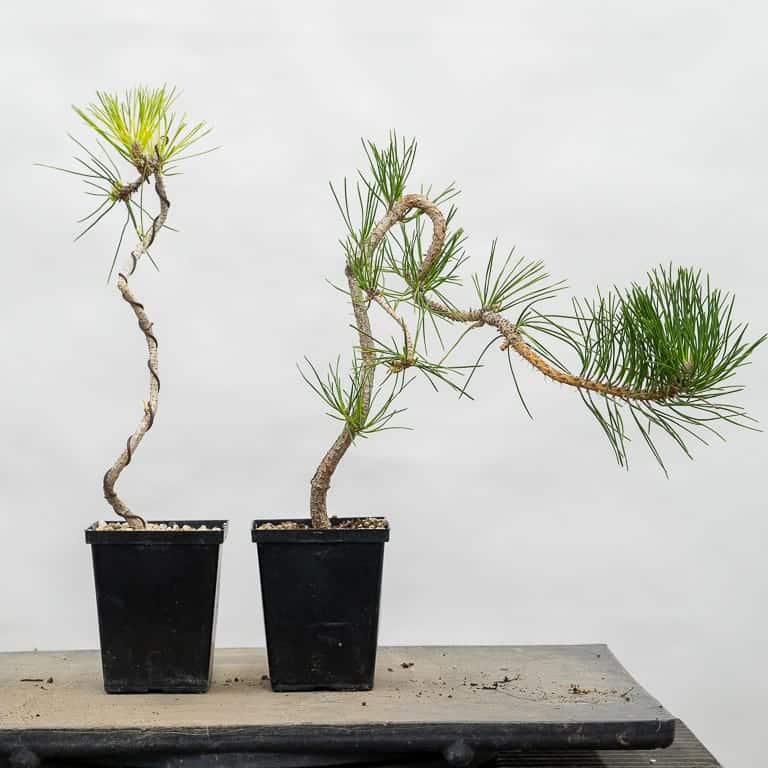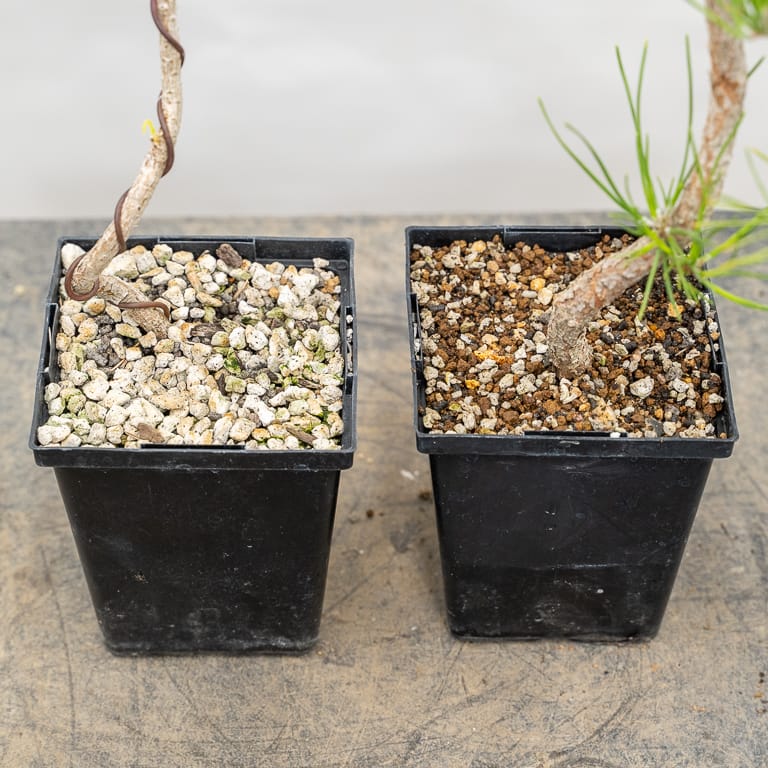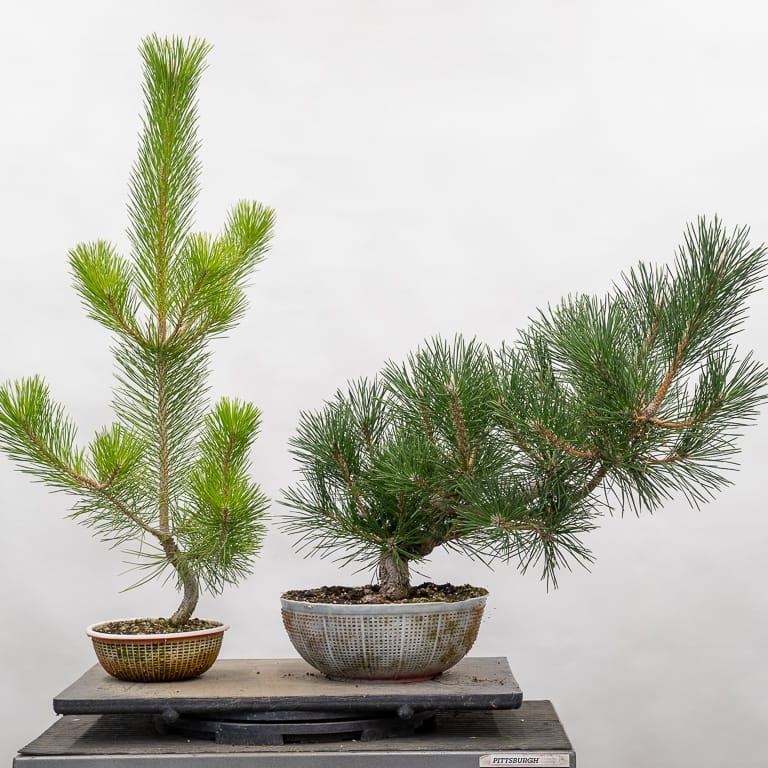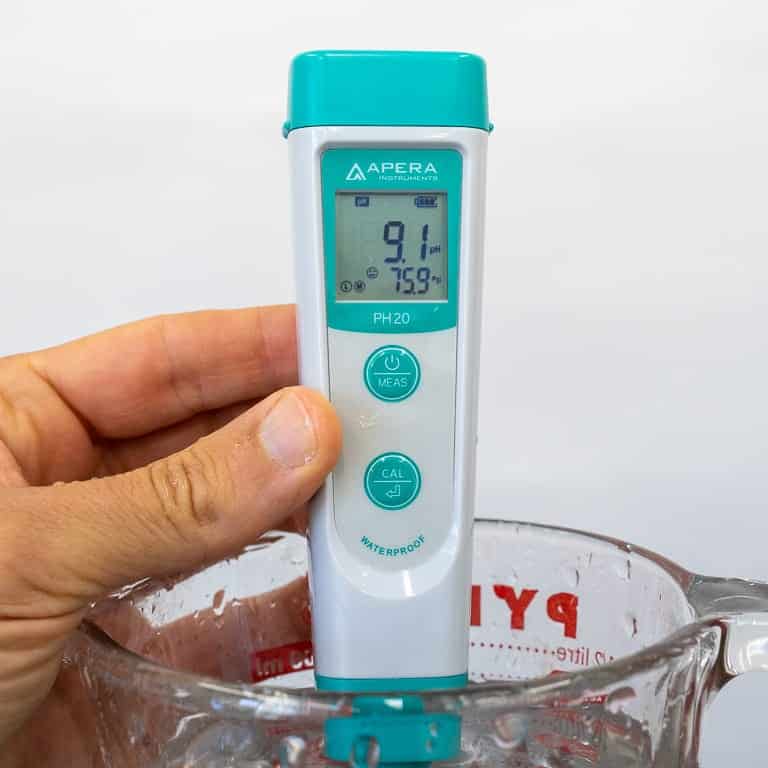I’m used to the pines in my garden looking a certain way. They usually yellow a little in fall and green up again in spring – only this spring, many remained yellow.
I figured part of that was a result of fertilizing late this year. But even after fertilizing for a couple of months, many of my pines remained yellow. Here’s an example of a yellow pine next to a greener one.

Young pines with yellow and green foliage
Among a group of these young pines, about one third were green and the rest were yellow. Looking closer, it turns out the yellow pines were in a different soil mix.

Different mixes
The tree on the left is planted in a mix of 75% pumice and 25% mulch. The tree on the right is in a mix of 30% akadama and 70% pumice and lava.
Over the years I’ve grown healthy pines in both of these mixes, but I’ve found that their water needs are different. The pumice and akadama mix dries out quickly, and the pumice and mulch mix dries slowly. When I keep trees in the two mixes together, I end up overwatering the mulch mix which contributes to the yellow foliage.
A second factor working against the mix with mulch is that the organic material I used is likely spent after a year and no longer offers much nutrition. When I grow pines in pure pumice mixes, I find it can be difficult to keep the trees green, possibly due to pumice’s low cation-exchange capacity (CEC – a soil particle’s ability to hold onto charged particles like fertilizer).
If the mulch has completely broken down, the pumice has trouble holding onto fertilizer, and the pines stay yellow.
Problem solved? Not quite. The pines below are both planted in mixes with pumice and akadama.

Yellow and green pines
For the last fifteen years, I’ve grown pines on the same few benches in my garden. This spring, I moved a few of the pines in colanders to a spot on the ground toward the back of the garden. The trees on the ground were dark green.
I can think of a few differences between these two environments. The trees on the ground stay cooler when it’s warm and warmer when it’s cold. It’s a bit less windy and possibly more humid near the ground. There’s also more available water as the excess sits on the ground before soaking in, and the spot on the ground gets a bit less sun than the trees on the bench.
Every one of these differences favors the production of green foliage on the trees growing on the ground. I don’t know how much greening is attributable to each, but as soon as I noticed this I moved a lot more pines onto the ground.
Now we’re getting close to solving the puzzle – but not quite. A small number of pines on the ground were still yellow. They were in good soil, they were fertilized regularly, and there were no signs of pests – not even root aphids.
That’s when I started thinking about how hard is was to get my trees to green up this year. And that’s when the light bulb went off.
Before I even checked, I knew what the problem was. It hadn’t been a problem for a couple of years, but apparently it was bad this year (it was). It was the pH of the water.
I got out the pH meter and was disappointed by the reading: 9.1

A high pH reading
As a sanity check, I looked up the pH reported by my water utility: 9.35.
And that explains the yellowing. I’m happy – and a bit amazed – that so many of my trees were getting by with such basic water, and even happier that I now know what to do to green up the last yellow trees in the garden: acidify the water. More on that topic in the next post.
Subscribe to Bonsai Tonight
New Posts Delivered Every Tuesday and Friday
Kim Chamberlain says
Thank you I have a shore pine that has been looking like that for a few years. I will try a bit of acidifing
Jonas Dupuich says
Hi Kim – do check the pH first as many things can cause yellow foliage in pines!
Jerry Carpenter says
Other issues recently was a fungus hitting pines there were very stressed and caused needle drop and tree death. This is never a simple answer.
Jonas Dupuich says
Thanks Jerry! And for those who don’t know about it, check out Jerry’s blog here.
Olivier PHILIPPI says
Dear Jonas,
Thanks for sharing all your knowlege. I gone throught the same issue some weekd ago, and after checking pH i started acidification using a water powered dosing pump and a solution of phosphatic acid. I was wondering how you come to the conclusion that pH is the reason, as as you said, some trees are green other yellow but all of them get the same water. Thanks a lot !
Jonas Dupuich says
Great question Olivier! The water doesn’t account for the difference between individual trees as much as it accounts for how difficult it has been to get all of my trees green this year. I came to the conclusion because I’ve dealt with this before and it was the same thing last time.
As for the differences between trees in the garden, I’ve found that the trees that were recently repotted are more likely to be yellow than green. The healthiest, most vigorous trees are typically green while the slightly less healthy or vigorous trees are more likely to be yellow. My guess is that these subtle differences account for the different colored foliage I’m seeing today.
Does this make sense – and can you think of additional reasons for the differences?
Luigi says
Hi Jonas,
very interesting post as usual.
I wrote you on the same subject in Ask bonsai tonight a couple of years ago.
Still I have the same problem, some pines are dark green and some are yellowish. I planted one of the yellowish pine in the ground and it turned dark green quite immediately.
I think water is the problem, what i do not understand why some are dark green and some not.
I decided to add some Osmocote for acidophile plants (citrus) only to the yellowish ones. I will see if they recover.
My water supplier says that the water acidity is PH 7.5
Thank you for the great blog.
Jonas Dupuich says
Hi Luigi – good question. You’re water pH is high but not terribly high. If some trees are yellow I’d guess the roots aren’t as healthy as the roots on green trees. If the trees have the same sun, same fertilizer, and same water availability, there are a few things to check. To start, I’d check the soil every day before I water. If the soil is wet, I’d wait to water. You can also try to encourage mycorrhizae, either from the healthy trees or from fertilizers that come with mycorrhizae. In my experience, mycorrhizae won’t grow as well when the soil is too wet. Most importantly, I’d try to find out what’s different between the yellow and green trees in your garden as that will provide the best clue for what to try next. Were some trees repotted last year? Were some trees suffering from insects or fungus in the past? Were different amounts of roots cut during repotting? Any small difference might make a difference.
Hope this helps!
Alessandro says
Hi Jonas! The conditions of my 3 pines (!) are the very same (water, sun….) but sometimes one turn a lite yellow . No insects nor fungus.
In this case i’m used to spry that pine with a solution of water and chelated iron (ferro chelato in italian) until it turns dark green!
Alessandro
Luigi says
Hi Alessandro,
nice to here that you hadsuccess tofix the yellowish pines with ferro chelato.
Where are your pines growing in italy?
Alessandro says
Ciao Luigi! I’m from Venezia near San Marco square (so I’m a real venetian guy!😂)
Alessandro
Jonas Dupuich says
Hi Alessandro! That’s great the the iron helped with your yellow pine. Overwatering and high pH are two of the most common causes of chlorosis so that provides some clues to watch out for going forward.
Olivier PHILIPPI says
Thanks a lot for your quick response, Jonas. Well, i don’t have so much experience and didn’t pursue a scientific study, but there are 2 main reasons that brought me to think about pH issue. First, the longer at my place, the yellowisher are the pines, despite reasonable good health (second growth on scott pines and i live in north east france). Second, my Mugo pines are bright deep green. After checking different sources, it seams that Mugo needs pH between 6.5 to 7.5 where Scott Pines feels well between 5.5 to 6.5. The numbers are approximative as i didn’t found one and only one realable source. Anyway at this point i think we have to differentiate pH of the water from this from the soil, and here it is more complicated. I was asking myself if over the years the soil wasn’t stocking the limescale of the water, and wonder if one should clean soil mix with acid or vinegear before re-using. After doing the aftermath and discussing on bonsai forum i checked pH of my water was over 8.0, so it was clear i had to do something. Of course pH and water hardness are 2 different things, but it seams that lower the pH can help solving higher hardness. Did you check on this parameter as well ?
Jonas Dupuich says
Thanks so much for the note Olivier – you make several good points! First, that different trees thrive in situations with different pH. (Are your mugo pines healthier than your Scots pines?) Second, that pH is complicated when we start to think about the soil and the water and their interactions over time. Third, in many cases, water hardness is more important than pH considering how prevalent hard water is in many places.
On the third point I am fortunate that my water has low mineral content, often between 30-40 mg/L. On the second point, I’m glad you brought up reusing soil. I don’t reuse bonsai soil so I may be avoiding problems relating to CEC or salt build-up. Trees growing in reused soil that prefer acidic environments and are watered with high pH and high mineral content water will likely have a tough time!
Olivier PHILIPPI says
Dear Jonas,
yes’ll check on this re-using soil point, in fact i don’t want to throw pumice away. Maybe wash if in vineager could help. To answer your question, both Mugo and Scotts are growing pretty well, depending off course mainly on which stage of their evolution they are (recovering collecting, repotting…). I would say Scotts Pines that are Yellow are more subject to pest attack, then others. I have the feelling, that this pH thing could be an issue on middle-, long term… But my journey in Bonsai world is so far too short to get to this.
BR,
Olivier
Jonas Dupuich says
Hi Olivier! If you want to reuse pumice, I’d recommend letting it dry in the sun and then sifting it to remove any dust. I’d then add fresh akadama. Pumice has very low CEC so I don’t expect that to change in any meaningful fashion.
As for why I don’t use a fully automatic system, I like to water trees only when they need it. As much as possible, I try to skip trees that are wet and water the ones that are dry. It’s not hot enough where I live for everything to dry out between waterings so I do a lot of spot watering (or skipping) as my schedule allows. Putting trees on a fully automatic system would be great for most, but not all of my trees, so in the meantime I’ll be watering by hand. I had all of my trees on a system for years and hope to have at least some on a system again before long.
I also don’t fertilize every tree with every watering. This can be good for younger trees, but mature trees like decandled pines, often require more specific fertilizer regimens.
Hope this helps!
Sandra says
Interesting that others are experiencing yellowish pines thus year. I have a Japanese white pine that turned yellowish last fall. It budded out this sprint and is forming new buds for next year. It’s in lava and pumice and has been in that for 3 years.
So it seems healthy other than the color. I’m going to try chelated iron and see if that helps.
Marc says
Maybe a hint that works for you: some years ago I’ve read that a little toot of iron powder works great for keeping pines in a nice green colour. I did tried it out last and this season and it worked for me. For more info, you should check out the blogs of Walter Pall. He came up with the idea by trying it out on white pines.
Jonas Dupuich says
Hi Marc! Iron is great and it’s a quick way to green up trees – it’s a common practice in the nursery industry. What’s interesting is that when trees are stressed, over-watered, or irrigated with very high pH water, the iron in the soil and/or fertilzer is less available to the tree. Adding iron is a good shortcut to improve health, but it’s also a sign that an underlying problem may be present. Thanks!